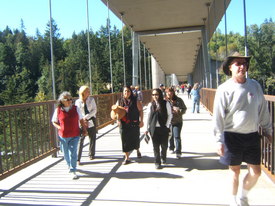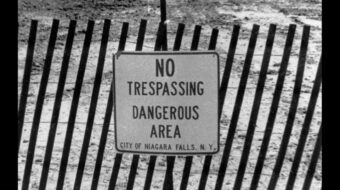
PORT ANGELES, Wash. – A big crowd gathered on a perfect autumn day, Sept. 25, to cut the ribbon on the new bridge over the Elwha River, a stream that rises in the Olympic Mountains and flows down through the Lower Elwha Klallam tribal reservation and empties into the Strait of Juan de Fuca.
Elected officials hailed the project as a symbol of unity and a shared purpose, first big step in a project that also includes removal of two dams upriver blamed for the near extinction of the salmon that once teemed in the clear, glacial waters.
Drummers and singers from the Klallam tribe sang a blessing and Lower Elwha Klallam tribal chair Frances Charles told the crowd, “This is a great opportunity for us, for our youth, for our elders, for our community.”
Port Angeles Mayor Gary Braun said, “This is what happens when you work together. What a beautiful connection between the Elwha community and the Port Angeles community!”
The ribbon for the ribbon-cutting was woven from cedar bark by women of the Lower Elwha tribe.
Arlene Wheeler, coordinator of the tribal drummers, told the World, “It’s wonderful, it’s awesome to see this project done in such a collaborative way. We were just now talking about the dam removal and wondering if this bridge will be high enough once the dams come down.”
Arlene Wheeler, coordinator of the Lower Elwha Klallam drummers, on the newly-dedicated bridge.
She said she and other members of the tribe had looked down into the river flowing beneath the bridge and seen salmon swimming upstream to spawn. “We were just enjoying the sight of the salmon,” she said. “We could see them swimming. Restoring the fish run is so important for the future of our children and grandchildren. They are going to see a replenishment of the salmon that has been such a big part of the everyday life of our people.”
Hundreds of pink salmon spawned in the rivers of the Pacific Northwest this year, a hopeful sign that efforts to restore the salmon runs is finally paying off.
She was not alone in seeing the new bridge as a step in the resurrection of the Elwha and the salmon that once spawned in its clear, glacial headwaters.
Already preparations are under way for the next step: taking down two dams a mile or so upriver, blamed for the near extinction of the salmon. The schedule for the dam removal, with an estimated cost of $308 million, was advanced by a full year when $57.8 million was earmarked for the project from President Obama’s American Recovery and Reinvestment Act.
Not least of the merits of the Elwha restoration project is the creation of hundreds of good-paying jobs on the hard-hit north Olympic Peninsula, on urgent infrastructure repair projects. The new bridge replaced the one-lane steel truss bridge completed in 1914, the same year the hydroelectric dam on the Elwha was completed. The old bridge, known to have many structural defeats, was closed within hours of the catastrophic collapse of the I-35W bridge over the Mississippi, Aug. 1, 2007.
Warren Hallam, construction manager for Parsons Construction, builder of the bridge, hailed the role of AFL-CIO Building Trades unions in providing the skilled workers needed on the project. The firm assigned 48 of its own employees and hired 167 subcontractors who worked a total 85,000 hours on the job, he said.
“All of the unions were fully cooperative,” Hallam told the World. “We didn’t know how many workers with the necessary crafts and skills would be available here on the Olympic Peninsula but the workers all came forward from day one with the level of skill we needed. They came straight out of the union halls with excellent training in their apprenticeship programs. They were all paid the prevailing wage.”
The hope is that the Elwha restoration effort, especially removal of the two dams upriver, will restore one of the biggest and most bountiful runs of king, silver and pink salmon in the Pacific Northwest, perhaps the biggest of many efforts to reclaim badly degraded salmon and steelhead rivers in the region.
There was great excitement this fall that for the first time in more than a decade, hundreds of king and silver salmon returned to the Sol Duc River, about 30 miles west of the Elwha. Big crowds gathered along the banks of Salmon Cascades on the upper reaches of the Sol Duc River in Olympic National Park to watch the gleaming salmon leap up the falls on their way to spawning beds above Sol Duc Hot Springs.
On a less dramatic scale, schools of pink salmon, and even some king and silver, arrived in the shallows of the Dungeness River at Mary Lukes Wheeler County Park to spawn this fall.
The salmon have been badly depleted by overfishing and habitat loss due to clearcut logging, real estate overdevelopment and global climate change but the North Olympic Salmon Coalition, the Clallam Conservation District, Friends of the Fields and other environmental organizations are fighting to restore streams and curb the damage caused by overdevelopment.
greenerpastures21212@yahoo.com

MOST POPULAR TODAY

Zionist organizations leading campaign to stop ceasefire resolutions in D.C. area


High Court essentially bans demonstrations, freedom of assembly in Deep South

Afghanistan’s socialist years: The promising future killed off by U.S. imperialism

Communist Karol Cariola elected president of Chile’s legislature






Comments